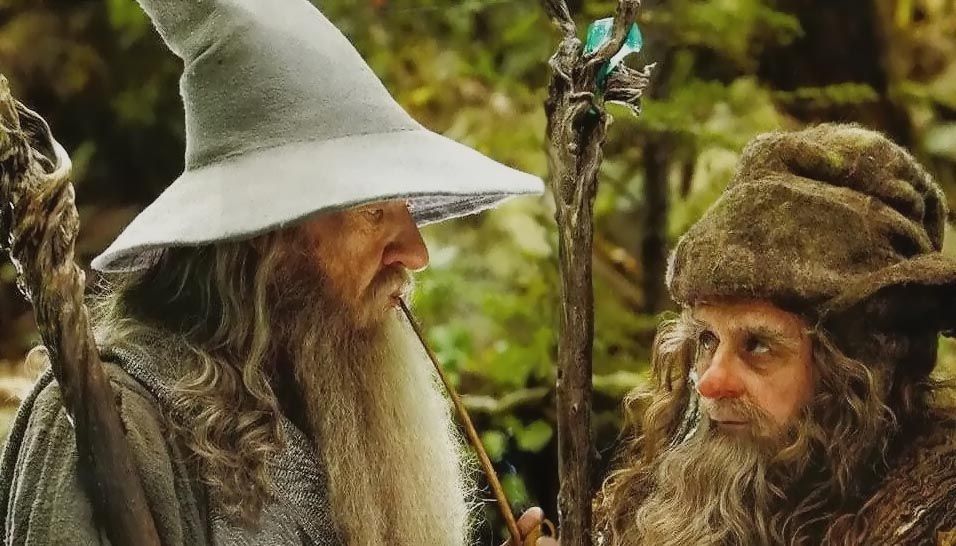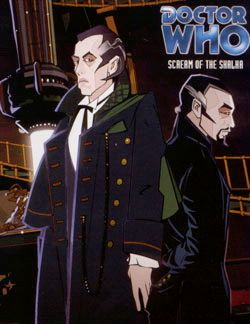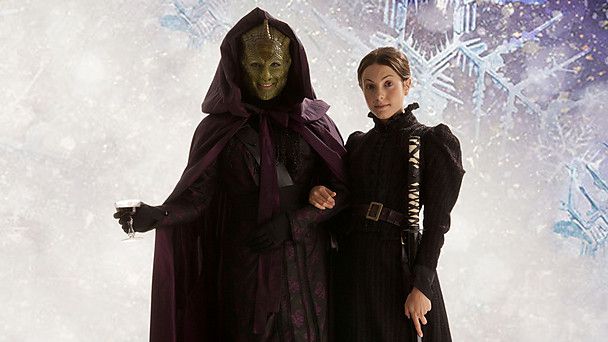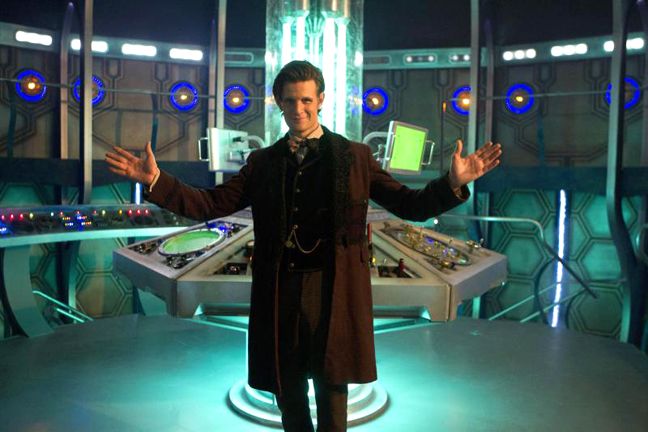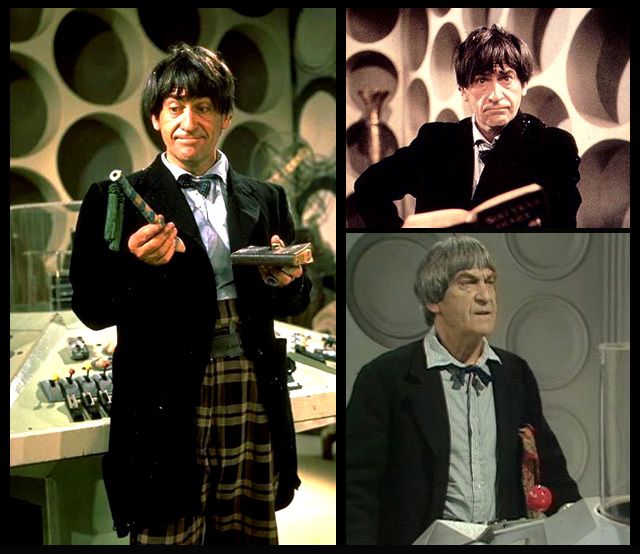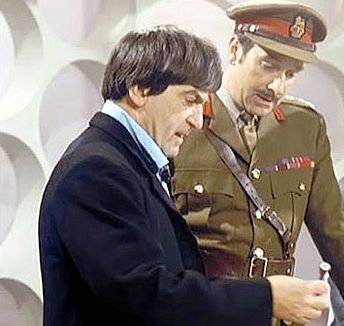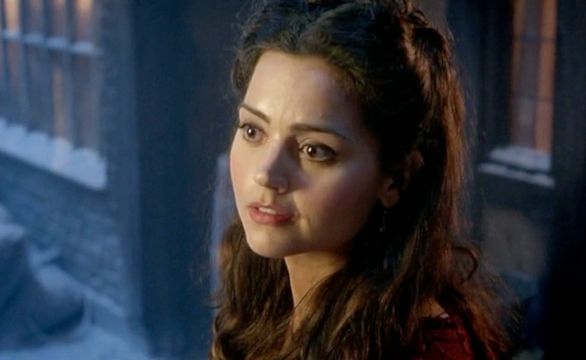For many fans, Dec. 25 means a new Doctor Who Christmas special. With the show's seventh season being split-up into two halves broadcast nearly a year apart, Whovians have been eager to see the heroic Time Lord again. Starring Matt Smith as the Eleventh incarnation of the Doctor, "The Snowmen" also introduces Jenna-Louise Coleman as new companion Clara, although the actor also appeared in the earlier episode "Asylum of the Daleks."
But how does this new special connect to previous adventures of Doctor Who? What nods does it give to friends and enemies of the past? Spinoff Online has put together annotations to the episodes for fans old and new.
Weeks before "The Snowmen" was broadcast, a prequel minisode titled "The Great Detective" hit online, featuring Vastra, Jenny Flint and Strax. All three characters were introduced in the Eleventh Doctor episode "A Good Man Goes to War" as individuals the Doctor had worked with before, although the circumstances of their first meetings have yet to be revealed.
"The Great Detective" was narrated by Mark Gatiss, who has written Doctor Who novels and episodes, portrayed the Doctor in an independent production, played the Master in a Big Finish Productions audio play, acted as Dr. Lazarus in the Tenth Doctor adventure "The Lazarus Experiment," and co-created the BBC series Sherlock with Steven Moffat. On Sherlock, Gatiss plays Sherlock's brother Mycroft.
Strax was killed in "A Good Man Goes to War"; in this special, the Doctor mentions later to Clara that a friend of his resurrected Strax. Who this friend is and how this happened is not revealed. However, as Strax uses advanced tech later in the episode to revive Clara, it's possible that is what was used to bring him back. The technology isn't perfect, obviously, since Strax has suffered a lost of intelligence and Vastra later remarks to the Doctor that (at least when severe injuries are involved) the device "can bring back anyone for a while, but long term..." with an ominous trail-off.
The episode reveals a new credits sequence for Doctor Who where Matt Smith's face flies towards the viewer. This element was used for the opening credits of the Second through Seventh Doctors in the original, classic program, from 1966 to 1989.
"The Snowmen" begins in 1842 and then jumps to 1892. This puts it a few years after the crimes of Jack the Ripper, which were halted by the Silurian warrior Vastra (as mentioned in "A Good Man Goes to War").
The Intelligence is voiced by Sir Ian McKellen, who has a few other connections to Doctor Who. He has starred twice alongside Sylvester McCoy, who portrayed the Seventh Doctor. The two were together in the Royal Shakespeare Company's production of King Lear telecast and currently share the screen as Radagast the Brown and Gandalf the Grey in The Hobbit: An Unexpected Journey. McKellen also starred with Shalka Doctor Richard E. Grant in a one-night benefit performance of the play Bent in 1989, after which he appeared in a full-run revival alongside Ninth Doctor Christopher Eccleston. In 1996, McKellen was actually considered for the role of the Eighth Doctor.
Richard E. Grant appears in "The Snowman" as Doctor Simeon. Grant is a man with multiple connections to Doctor Who. One of Grant's most famous roles was the titular character of Withnail and I, where he co-starred with Paul McGann, who would go on to be cast as the Eighth Doctor. In 1999, he starred in the Red Nose Day comedy special "The Curse of Fatal Death," written by Steven Moffat. Grant played a version of the Doctor who described himself as "lick-the-mirror-handsome."
In 2003, when it still seemed unlikely to many that Doctor Who would return as a television series, the BBC announced it would officially continue the Time Lord's adventures through flash-animation stories on the program's official website. Grant was announced as the official Ninth Doctor and was recorded for the first webcast adventure "Scream of the Shalka," written by Paul Cornell (writer of Doctor Who episodes, audio plays and novels). Taking place some time after the Eighth Doctor's end, this Ninth Doctor was apparently forced to work for the Time Lords again and was partnered with his old enemy the Master, whose mind was now locked inside an android body that couldn't leave the TARDIS. The animated story featured Derek Jacobi as the Master (a role he would reprise) and Sophie Okonedo (who would later play Liz 10 in the Eleventh Doctor episode "The Beast Below") as the new companion Alison.
Months before this animated webcast was released, it was announced Russell T. Davies would bring back Doctor Who as a live-action series on the BBC in 2005. Davies later criticized Grant's portrayal and decided not to consider it part of the canon, stating that Christopher Eccleston was the official Ninth Doctor (later verified by BBC press releases and dialogue within the program itself). Since then, Grant's Doctor has been considered to be from an alternate timeline and is often referred to as the "Shalka Doctor." The Shalka Doctor was later featured in a novelization of "Scream of the Shalka" and in the short story "The Feast of the Stone" by Cavan Scott and Mark Wright.
Vastra is revealed to be the inspiration for the character Sherlock Holmes. Holmes has been compared to the Doctor on many occasions, and his enemy the Master was directly inspired by Holmes' enemy Professor Moriarty. Coincidentally, Grant referred to his own portrayal of the Doctor in "Scream of the Shalka" as "Sherlock Holmes in space." The Fourth Doctor story "The Talons of Weng Chiang" had the Doctor wear a deerstalker cap (often associated with Holmes), learn about a housekeeper named Mrs. Hudson (the same name as Holmes' landlady), and encounter a giant rat (reminiscent of a famous untold story of the great detective). The 1994 novel Evolution suggested that Arthur Conan Doyle actually based some elements of Sherlock Holmes on the Fourth Doctor. "The Talons of Weng-Chiang" also introduced the Time Agency, the same agency associated with later character Captain Jack Harkness (introduced in the Moffat-penned episode "The Empty Child"). In the Big Finish audio play "Legend of the Cybermen," Sherlock Holmes is referred to as an inhabitant of the Land of Fiction (a place the Second Doctor visited in "The Mind Robber").
Despite these many references to Sherlock Holmes being fictional, the 1994 novel "All-Consuming Fire" had the Seventh Doctor encounter Holmes and Watson as if they were real people. Together they fought creature called Azaroth, one of the "Great Old Ones," a title also used to refer to the Great Intelligence.
Doctor Simeon remarks on Vastra having a suspiciously intimate relationship with her aide Jenny Flint. There have been several essays and theories over the years concerning a possible romantic interest (if not full relationship) between Holmes and Watson.
Strax has difficulty distinguishing gender. In the very first Sontaran adventure, "The Time Warrior," the Sotaran called Linx was confused when he encountered Sarah Jane Smith, initially believing she was part of a different species before realizing that humans have two genders, then criticizing the process of sexual reproduction as "inefficient" and suggesting that it be changed.
When the Eleventh Doctor first appeared and his TARDIS rebuilt itself, Moffat made it a point to have the ship look bright and new on the outside rather than used and worn. However, it seems that not only has time passed since we last saw the Doctor, but that he has stopped maintaining some of her systems, and so she looks much older on the outside.
Notice that Vastra's personal study seems almost tropical. She may be recreating the environment she originally lived in, when Silurians ruled the Earth during prehistoric times. As a reptilian being, she also no doubt prefers warm climates over English winters.
The Doctor is using reading glasses. This incarnation realized that reading glasses were helpful in the episode "The Angels Take Manhattan," the same story that led to his temporary retirement. The First Doctor needed glasses on several occasions, but when the Second Doctor put them on (minutes after his regeneration), he realized that his eyes had improved. The Fifth Doctor and Tenth Doctor occasionally wore glasses, but the Tenth Doctor revealed in the mini-episode "Time Crash" (written by Moffat) that he and his Fifth incarnation only did this when they wanted to look clever rather than because of any optic weakness.
The Doctor reacts to the word "pond." The current Doctor entered his retirement soon after circumstances led to a forced separation from his former companion Amy Pond and her husband Rory Williams in "The Angels Take Manhattan."
Walter Simeon remarks to the Doctor that he reads The Strand. This was the publication where the Sherlock Holmes stories first appeared. The stories were written as if John Watson were sharing his adventures with the readers and Holmes himself would occasionally remark, with great criticism, how these accounts of his skills in The Strand were poorly written. A large number of fans believed that these stories were indeed factual rather than fiction, so it's not entirely absurd that Simeon's servant believes the Doctor actually is Sherlock Holmes.
The Doctor mentions that his sonic screwdriver has a new "anti-freeze" setting. In the original show, the screwdriver was used for the purpose its name implies and to unlock doors or mess with computers. It also had limited sensory applications. Producer John Nathan-Turner believed it was becoming akin to a magic wand and had the Fifth Doctor's sonic screwdriver destroyed. It was completely absent for the rest of his television adventures and the Sixth and Seventh Doctors never had a replacement before the classic TV series was canceled. In the 1996 TV movie, the Seventh Doctor was seen using a new sonic screwdriver just before he regenerated into his Eighth incarnation. In the modern series, Davies decided to seriously upgrade the sonic screwdriver into a multi-purpose tool, embracing the idea that it was a science fiction equivalent of a magic wand.
While saving Clara, the Doctor realizes he has put on a bow tie, which he usually wore ever since the first hour of his regeneration. Notice the bow tie's color. During the Eleventh Doctor’s tenure, there has been a general rule that he wears a blue bow tie during adventures that take place in the past and a red one during adventures in the present day and future (though there have been exceptions to this). The color-coded bowtie is a reference to Russell T. Davies' decision to color-code the time tunnels that the Ninth and Tenth Doctors traveled through, as seen during their opening credits sequences. Blue time tunnels led into the past, red time tunnels led into the present or future. A rumor that a similar color rule existed for the suits David Tennant wore as the Tenth Doctor is false.
As Clara holds her umbrella and rises into the sky, she resembles another umbrella-wielding, flying governess from British literature: Mary Poppins, who featured in several books published between 1934 and 1988, as well as a famous Disney film adaptation, which itself was adapted into a Broadway musical. Many Doctor Who fans have joked that Mary Poppins was likely a Time Lord herself.
The TARDIS interior has altered itself yet again. This has happened many times throughout the classic and modern programs. The control console now greatly resembles the style of consoles used by the first seven Doctors. Likewise, the room involves more metal, as many of the Control Rooms for the first seven Doctors did. However, the symbols that circle the time rotor as it connects to the roof are modern Time Lord glyphs introduced during the Ninth Doctor's season. There are also now, for the first time, two scanner screens.
The TARDIS resuming a more alien appearance could be symbolic of the Doctor retreating from humanity and once again becoming more like a traditional Time Lord. Time Lords had rules against interference, and saw other races as beneath them. Along with repeatedly choosing not to get involved "for a long time now," the Doctor has literally placed himself above humanity by hiding on a cloud.
Clara asks if there's a kitchen on board the TARDIS. The First Doctor was seen using a machine that created small bars that could nourish travelers and would taste like whatever food you programmed them to. Later adventures did occasionally refer to a kitchen, and Rose Tyler mentioned in "The Empty Child" (also written by Moffat) that the Doctor liked to visit Earth when the TARDIS was "out of milk."
The monster, which the Doctor calls "the Intelligence," lives in a sphere and is able animate snow, ice and the dead. The Doctor realizes that this seems familiar, as does the name "Great Intelligence." It's understandable he doesn't remember, since from his perspective he hasn't encountered the Great Intelligence for over half a millennium.
In the television story "The Abominable Snowmen" (first broadcast in 1967), the Second Doctor (who commented that he was in the middle of his fourth century of life) landed in Tibet in 1935 and fought a creature calling itself the Great Intelligence, a disembodied spirit. To aid its goals, this villain took control of a person and extended its power through control spheres that operated artificial yeti. The Great Intelligence shared a few qualities with another creature known as the Animus, who had fought the First Doctor in "The Web Planet" (broadcast in 1965). Later tie-in writers referred to the Great Intelligence and the Animus as both being "Great Old Ones," beings that had apparently existed before the current universe. According to Davies in Doctor Who Annual 2006, these beings left our universe completely during the Last Great Time War.
The 1968 TV story "The Web of Fear" had the Doctor once again encounter the Great Intelligence, this time in London in the late 1960s (this date determined by remarks made in the Tenth Doctor adventure "The Sound of Drums" and BBC documentaries). The Great Intelligence now manifested itself as a web-like structure occupying the London underground. Once again, it used artificial yeti as its strike force.
Note that although "The Web of Fear" was broadcast in 1968, the map that the Eleventh Doctor holds is from 1967, the same year that the Great Intelligence first appeared on television. Since the Doctor brings this map to Simeon's home and shows it to the Intelligence, it is he who unwittingly convinces the creature that the underground is a weakness to be exploited more than 75 years later. The Eleventh Doctor accidentally helping ensure events that he already experienced is a bit of a paradox and Moffat has written several stories involving paradoxes and time loops.
"The Web of Fear" is significant also because it was when the Doctor first met Col. Alistair Gordon Lethbridge-Stewart (played by Nicholas Courtney), who was inspired by the experience to help create UNIT to act as Earth's protection during times when the Doctor was not around (originally the acronym stood for United Nations Intelligence Task force, but the U.N. asked the modern day Doctor Who program to not reference them, leading to the new name Unified Intelligence Task force). Lethbridge-Stewart was promoted to Brigadier and put in charge of UNIT's U.K. branch. He wound up teaming up with various other incarnations of the Doctor, even giving the Third Doctor a home and resources when the hero was temporarily exiled to Earth by the Time Lords. It was the Brigadier who destroyed a tribe of Silurians, an event seen in the Third Doctor "Doctor Who and the Silurians" and referenced by the Eleventh Doctor in "Cold Blood."
In modern times, the Ninth Doctor encountered UNIT in the episode "Aliens in London." UNIT forces were revealed to have a base beneath the Tower of London in the special "The Christmas Invasion." The Tenth Doctor encountered UNIT again in "The Sound of Drums" and "Last of the Time Lords," and reunited with the Brigadier in the pages of Doctor Who Magazine. When the Tenth Doctor fought alongside UNIT in the episode "The Poison Sky," he mentioned wishing that Alistair were there, leading a UNIT officer to comment that the retired Brigadier had been knighted and was on a mission in Peru. Sir Alistair himself then appeared in "The Sarah Jane Adventures," where he commented that UNIT was not as effective in protecting the Earth as it used to be due to modern politics (explaining the group's absence from many adventures). In "The Wedding of River Song," the Eleventh Doctor attempted to visit Alistair only to learn the man had passed away (mirror the fact that actor Nicholas Courtney passing away months earlier).
In "The Power of Three," the Eleventh Doctor met Kate Stewart, the new head of UNIT who said she had adapted the organization to focus more on scientific research rather than military solutions. Later, at the Tower of London base, the Doctor revealed he had realized Kate was actually Alistair's daughter.
The fact that the Great Intelligence has only previously appeared in Second Doctor adventures may or may not be connected to Matt Smith, who has often said that Patrick Troughton's bow tie-wearing second incarnation is his favorite of the past Doctors.
The Doctor realizes he met Clara (or another version of her) before. The Doctor has encountered other people and things that have seemingly appeared again and again throughout the universe. The Fourth Doctor encountered a man who was forcibly split across time periods in "City of Death" (written by Douglas Adams). The Fifth, Sixth and Seventh Doctor all seemingly encountered the same girl in three different times and places in the Big Finish audio play crossover “The Sirens of Time.” The Ninth Doctor and his companion Rose Tyler repeatedly encountered the phrase “Bad Wolf” across time and space. In these later two cases, the anomalies were caused by someone deliberately manipulating circumstances in the Doctor’s life.
That's all for now! Let us know if you want more annotations on Doctor Who adventures old and new.
Alan "Sizzler" Kistler is an actor, host and author who has been recognized by news media as pop culture historian focusing on U.S. superheroes and certain science fiction franchises. He is writing a history book on the Doctor Who franchise. The fact that he has been seen driving a TARDIS-blue Mustang is a complete coincidence.


